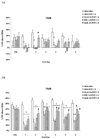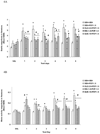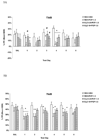Time course of the attenuation effect of repeated antipsychotic treatment on prepulse inhibition disruption induced by repeated phencyclidine treatment
- PMID: 21402097
- PMCID: PMC3081992
- DOI: 10.1016/j.pbb.2011.03.007
Time course of the attenuation effect of repeated antipsychotic treatment on prepulse inhibition disruption induced by repeated phencyclidine treatment
Abstract
Antagonism of prepulse inhibition (PPI) deficits produced by psychotomimetic drugs has been widely used as an effective tool for the study of the mechanisms of antipsychotic action and identifying potential antipsychotic drugs. Many studies have relied on the acute effect of a single administration of antipsychotics, whereas patients with schizophrenia are treated chronically with antipsychotic drugs. The clinical relevance of acute antipsychotic effect in this model is still an open question. In this study, we investigated the time course of repeated antipsychotic treatment on persistent PPI deficit induced by repeated phencyclidine (PCP) treatment. After a baseline test with saline, male Sprague-Dawley rats were repeatedly injected with either vehicle, haloperidol (0.05mg/kg), clozapine (5.0 or 10.0mg/kg), olanzapine (2.0mg/kg), risperidone (1.0mg/kg) or quetiapine (10mg/kg), followed by PCP (1.5mg/kg, sc) and tested for PPI once daily for 6 consecutive days. A single injection of PCP disrupted PPI and this effect was maintained with repeated PCP injections throughout the testing period. Acute clozapine, but not other antipsychotic drugs, attenuated acute PCP-induced PPI disruption at both tested doses. With repeated treatment, clozapine and quetiapine maintained their attenuation, while risperidone enhanced its effect with a significant reduction of PCP-induced disruption toward the end of treatment period. In contrast, repeated haloperidol and olanzapine treatments were ineffective. The PPI effects of these drugs were more conspicuous at a higher prepulse level (e.g. 82dB) and were dissociable from their effects on startle response and general activity. Overall, the repeated PCP-PPI model appears to be a useful model for the study of the time-dependent antipsychotic effect, and may help identify potential treatments that have a quicker onset of action than current antipsychotics.
Copyright © 2011 Elsevier Inc. All rights reserved.
Figures










Similar articles
-
Repeated effects of the neurotensin receptor agonist PD149163 in three animal tests of antipsychotic activity: assessing for tolerance and cross-tolerance to clozapine.Pharmacol Biochem Behav. 2015 Jan;128:78-88. doi: 10.1016/j.pbb.2014.11.015. Epub 2014 Nov 26. Pharmacol Biochem Behav. 2015. PMID: 25433325 Free PMC article.
-
Long-term impacts of adolescent risperidone treatment on behavioral responsiveness to olanzapine and clozapine in adulthood.Prog Neuropsychopharmacol Biol Psychiatry. 2014 Jan 3;48:177-85. doi: 10.1016/j.pnpbp.2013.10.005. Epub 2013 Oct 16. Prog Neuropsychopharmacol Biol Psychiatry. 2014. PMID: 24140929 Free PMC article.
-
Cognitive-disruptive effects of the psychotomimetic phencyclidine and attenuation by atypical antipsychotic medications in rats.Psychopharmacology (Berl). 2007 Sep;193(4):521-37. doi: 10.1007/s00213-007-0808-x. Epub 2007 May 12. Psychopharmacology (Berl). 2007. PMID: 17497138
-
Reversal of phencyclidine-induced prepulse inhibition deficits by clozapine in monkeys.Psychopharmacology (Berl). 2003 Sep;169(3-4):234-9. doi: 10.1007/s00213-003-1533-8. Epub 2003 Jul 4. Psychopharmacology (Berl). 2003. PMID: 12845408
-
Pharmacological studies of prepulse inhibition models of sensorimotor gating deficits in schizophrenia: a decade in review.Psychopharmacology (Berl). 2001 Jul;156(2-3):117-54. doi: 10.1007/s002130100811. Psychopharmacology (Berl). 2001. PMID: 11549216 Review.
Cited by
-
Antipsychotic-induced sensitization and tolerance: Behavioral characteristics, developmental impacts, and neurobiological mechanisms.J Psychopharmacol. 2016 Aug;30(8):749-70. doi: 10.1177/0269881116654697. Epub 2016 Jul 1. J Psychopharmacol. 2016. PMID: 27371498 Free PMC article. Review.
-
Repeated effects of the neurotensin receptor agonist PD149163 in three animal tests of antipsychotic activity: assessing for tolerance and cross-tolerance to clozapine.Pharmacol Biochem Behav. 2015 Jan;128:78-88. doi: 10.1016/j.pbb.2014.11.015. Epub 2014 Nov 26. Pharmacol Biochem Behav. 2015. PMID: 25433325 Free PMC article.
-
An Overview of the Association between Schizotypy and Dopamine.Front Psychiatry. 2014 Dec 19;5:184. doi: 10.3389/fpsyt.2014.00184. eCollection 2014. Front Psychiatry. 2014. PMID: 25566103 Free PMC article. Review.
-
Long-term impacts of adolescent risperidone treatment on behavioral responsiveness to olanzapine and clozapine in adulthood.Prog Neuropsychopharmacol Biol Psychiatry. 2014 Jan 3;48:177-85. doi: 10.1016/j.pnpbp.2013.10.005. Epub 2013 Oct 16. Prog Neuropsychopharmacol Biol Psychiatry. 2014. PMID: 24140929 Free PMC article.
-
Neural basis of the potentiated inhibition of repeated haloperidol and clozapine treatment on the phencyclidine-induced hyperlocomotion.Prog Neuropsychopharmacol Biol Psychiatry. 2012 Aug 7;38(2):175-82. doi: 10.1016/j.pnpbp.2012.03.007. Epub 2012 Mar 26. Prog Neuropsychopharmacol Biol Psychiatry. 2012. PMID: 22476004 Free PMC article.
References
-
- Abekawa T, Ito K, Koyama T. Different effects of a single and repeated administration of clozapine on phencyclidine-induced hyperlocomotion and glutamate releases in the rat medial prefrontal cortex at short- and long-term withdrawal from this antipsychotic. Naunyn Schmiedebergs Arch Pharmacol. 2007;375:261–271. - PubMed
-
- Agid O, Kapur S, Arenovich T, Zipursky RB. Delayed-onset hypothesis of antipsychotic action: a hypothesis tested and rejected. Arch Gen Psychiatry. 2003;60:1228–1235. - PubMed
-
- Andersen MP, Pouzet B. Effects of acute versus chronic treatment with typical or atypical antipsychotics on d-amphetamine-induced sensorimotor gating deficits in rats. Psychopharmacology (Berl) 2001;156:291–304. - PubMed
-
- Bakshi VP, Geyer MA. Antagonism of phencyclidine-induced deficits in prepulse inhibition by the putative atypical antipsychotic olanzapine. Psychopharmacology (Berl) 1995;122:198–201. - PubMed
Publication types
MeSH terms
Substances
Grants and funding
LinkOut - more resources
Full Text Sources

